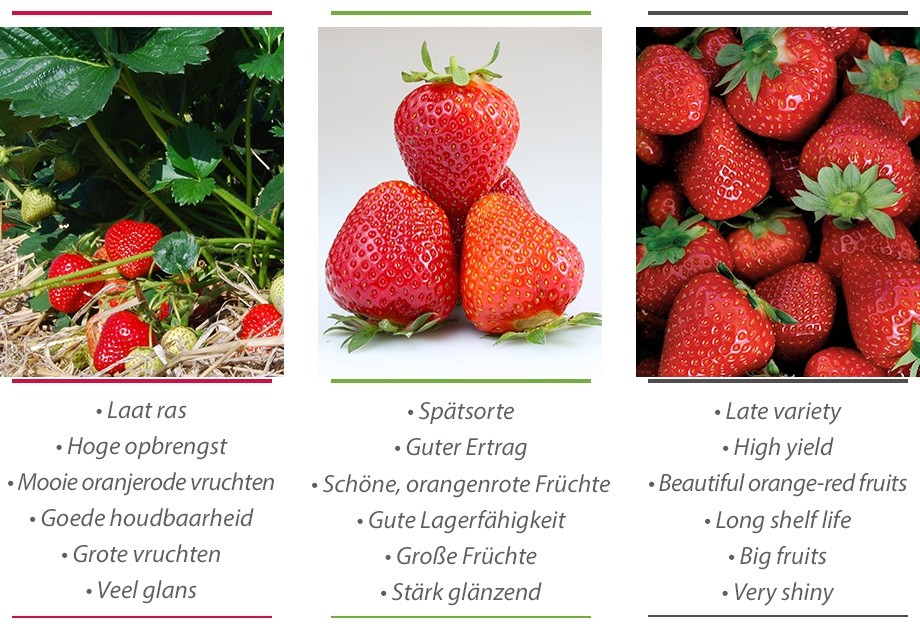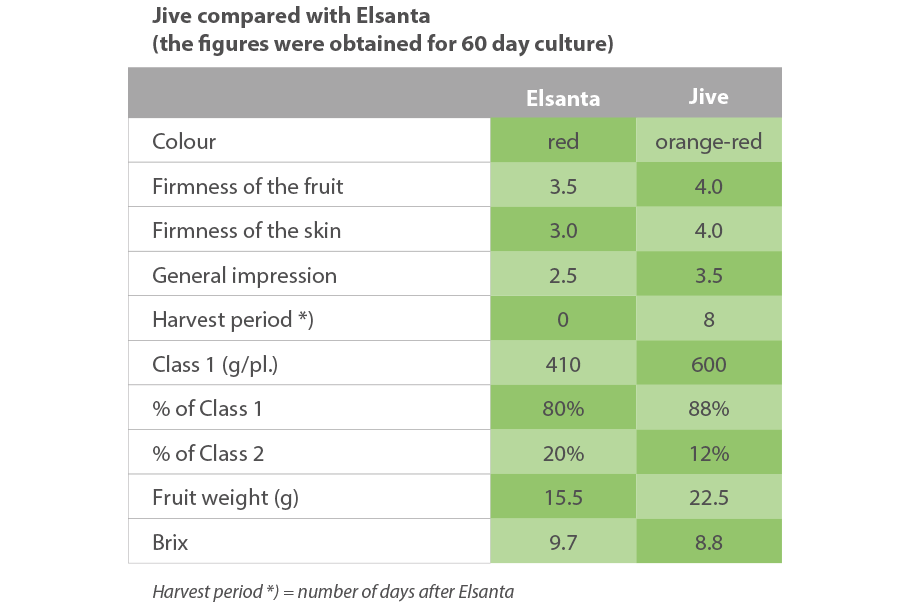Jive
Jive is a late June bearer with large, firm, very shiny orange-red fruit. The well-shaped, attractive berries are striking for a late variety. They ripen slowly and their harvest period is on average 7 to 10 days later than that of Elsanta. The plant is compact and robust, with a heavy, extensive root system and foliage of a conspicuous dark green colour. It produces only few runners, which means that most of the plant’s energy is directly available for the berries and flower trusses.

The information sheet of Jive can be found here.
Jive is suited to the cooler climates of Western Europe, primarily north of the Alps. It is an interesting alternative to Elsanta for sixty day culture in the summer production (in tunnels). Jive has greater resistance to heat stress than Elsanta and develops a sufficient canopy before the plants start flowering, even at high temperatures. Due to these characteristics, Jive bears fruits of a consistent size, enabling easy, fast harvesting.
Fruit quality
Jive
forms large, firm fruits with an appealing, slightly tart aroma. Its
uniform berries are usually elongated. The first ones have a somewhat
flattened nose. Jive’s glossiness, fruit size and attractive orange-red
colour are remarkable for a late-bearing variety. The slow ripening of
the fruits results in an average fruit weight that is significantly
greater than that of Elsanta. The fruits are also firmer and less
susceptible to bruising. Bruises will rarely be visible. Jive therefore
retains its attractive appearance for a long time and excels in shelf
life. The berries colour slowly, making it possible to delay harvest for
some time. Like all other strawberry varieties, Jive is susceptible to
rain damage in autumn. It is therefore advisable to cover sixty day
culture crops with tunnels in August. Jive should be given extra doses
of nitrogen and potassium to ensure a good fruit quality.
Flowering and picking period
Jive produces flowers of excellent quality, resulting in a low percentage of misshapen fruits. The flowering period is clearly later than that of Elsanta. The number of flowers per truss is lower, but this is compensated by the fact that Jive produces more trusses. This results in a fairly long, evenly distributed harvest period. The flower trusses remain just beneath the leaves. The optimum harvest time is when the fruits turn orange-red.
Productivity
The yields of Jive are significantly higher than those of Elsanta. The berries can be very quickly picked thanks to the high average fruit weight and the open crop type. Jive does not require much work in grading after harvest because of its uniform fruit size, low percentage of misshapen fruits, and the firm texture of the berries.

Susceptibility to pests and diseases
Jive’s susceptibility to Phytophthora cactorum is comparable with that of Elsanta. Jive is also susceptible to root rot (Cylindrocarpon spp.). Jive must be grown in soil with a good structure and must be treated to prevent root diseases at the time of planting.
Jive produces robust, strong crops. At the end of the harvest period Jive is susceptible to mildew, especially crops grown in tunnels, though this will usually be less than in the case of Elsanta. When grown in tunnels, Jive is susceptible to fruit rot (Botrytis cinerea) and additionally has an extended flowering period. Therefore, due allowance should be made for this risk in the crop protection programme.
Jive is protected by Plant Breeders’ Rights and is traded under licence.
